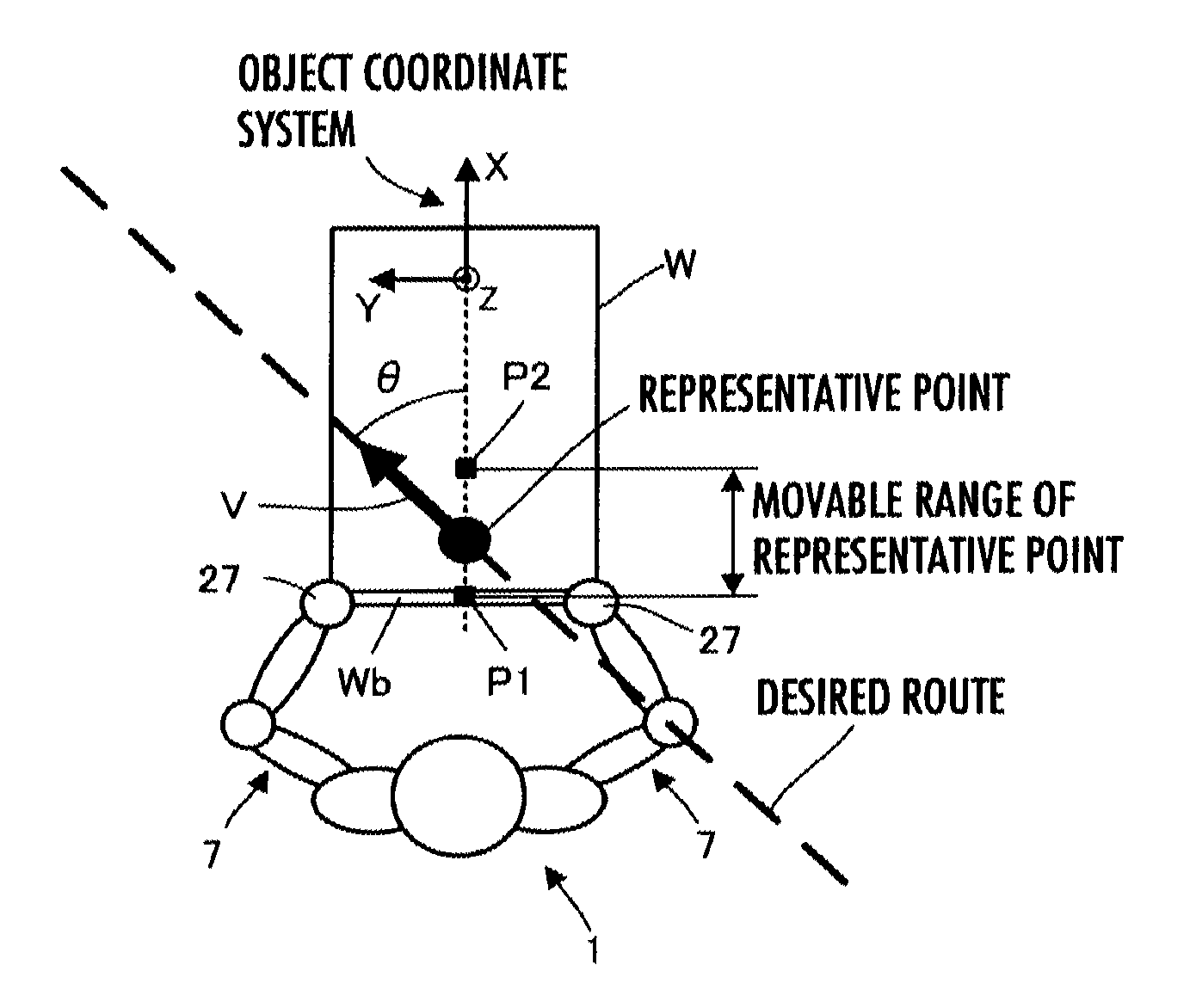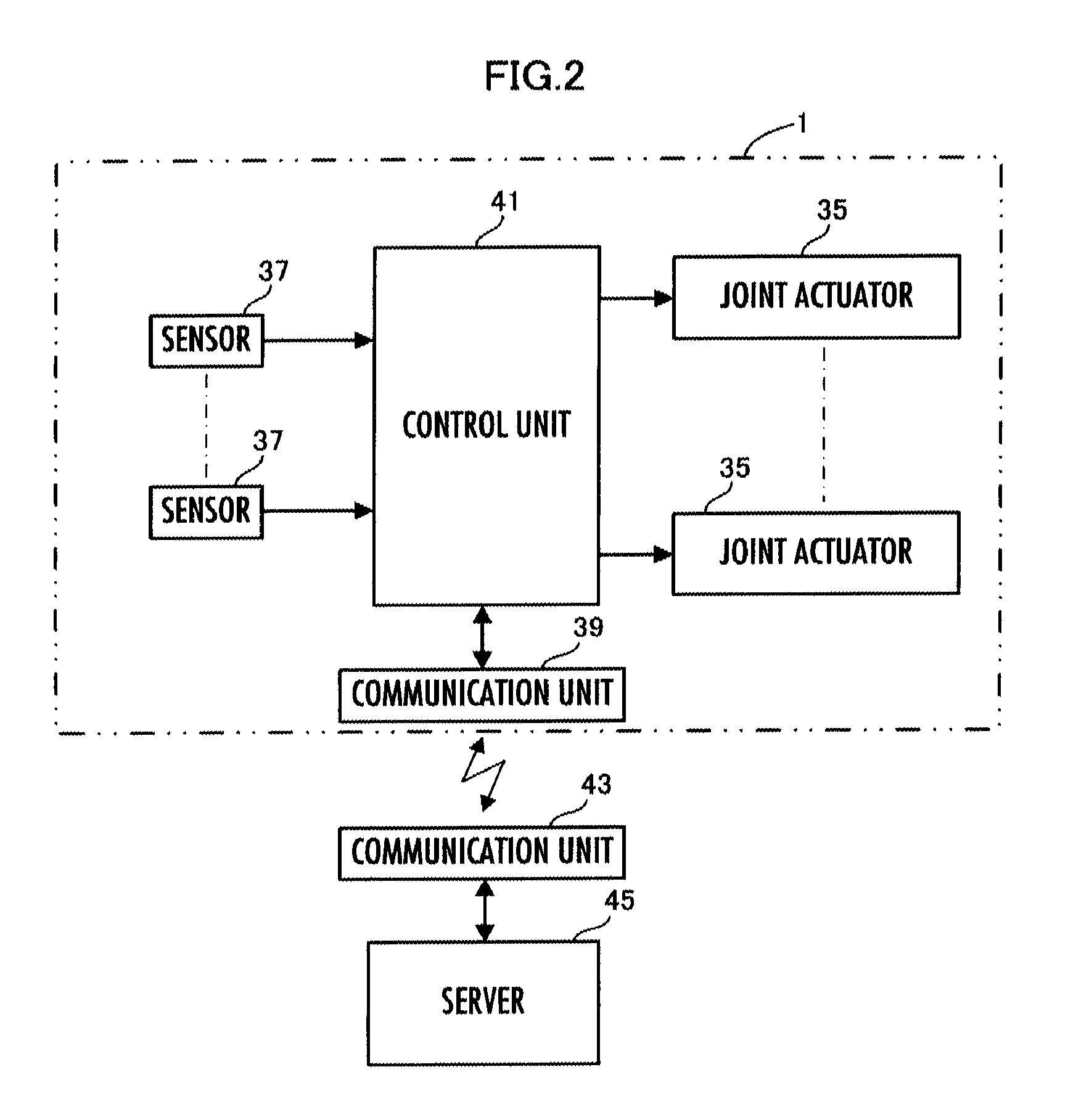[0016]The first aspect of the invention makes it possible to variably set the desired value of the angular difference about the yaw axis between the reference direction of an object and the direction of the moving velocity vector of the representative point of the object defined by the desired position trajectory (in other words, the tangential direction of a desired spatial route of the representative point of the object defined by the desired position trajectory) according to a required condition of the movement mode of the object. With this arrangement, the desired posture of the object about the yaw axis can be set to a posture satisfying a required condition of the movement mode of the object. Further, the motions of the mobile robot are controlled such that the position of the representative point of the object and the posture of the object follow the desired position trajectory and the desired posture trajectory which includes the desired value of the angular difference. This allows the object to be moved at a posture which satisfies the required condition of the movement mode.
[0018]More specifically, depending on the angular difference, the posture of the object about the yaw axis easily deviates from a desired posture due to a moment attributable to a force acting on the object from the mobile robot. In such a circumstance, adjusting the position of the representative point of the object (the position in the object coordinate system) makes it possible to reduce the inertial moment of the object about the yaw axis passing the representative point. Thus, reducing the inertial moment of the object allows the posture to quickly follow the desired posture while controlling the force required to be applied to the object from the mobile robot in order to make the posture of the object follow the desired posture to a relatively small force (i.e., while restraining the force from becoming excessive).
[0020]In the third aspect of the invention, since the predetermined portion of the object in contact with the distal portion of the arm of the mobile robot is the portion adjacent to one end of the object, the posture of the object about the yaw axis tends to deviate from the desired posture more easily when the object is moved by the mobile robot as the desired value of the angular difference is closer to the second angular difference, i.e., as the direction of the interval between one end and the other end of the object and the direction of the moving velocity vector become closer to an orthogonal state. Therefore, according to the third aspect of the invention, the position of the representative point is set such that the inertial moment of the object is reduced as the desired value of the angular difference is closer to the second angular difference than the first angular difference. This arrangement allows the posture to promptly follow the desired posture while controlling the force required to be applied to the object from the mobile robot in order to make the posture of the object follow the desired posture to a relatively small force (i.e., while restraining the force from becoming excessive) in the aforesaid situation wherein the desired value of the angular difference is closer to the second angular difference, causing the posture of the object about the yaw axis to easily deviate from the desired posture. Further, in the situation wherein the desired value of the angular difference is closer to the first angular difference, the inertial moment of the object becomes slightly large, permitting higher stability of the posture of the object about the yaw axis.
[0022]According to the fourth invention, the desired value of the angular difference is set such that the lengthwise direction of the object remains in parallel to the wall or the side surface of the installed object at least from the point at which the distance from the wall or the side surface of the installed object to the object reaches a predetermined distance or less to the destination. This arrangement makes it possible to bring the object close to the wall or the installed object such that the posture of the object at the destination will be the desired posture, namely, the desired posture in which the lengthwise direction of the object is parallel to the wall or the side surface of the installed object, by moving the object to the destination along a monotonous route without the need for changing the posture of the object at a location in the vicinity of the destination.
[0025]According to the fifth aspect of the invention, even in the case where an obstacle exists beside the desired route, making the width of the pathway through which the object and the mobile robot pass is relatively small, it is possible to move the object and the mobile robot through the pathway by setting the desired posture of the object which allows the object or the mobile robot to avoid colliding with the obstacle.
 Login to View More
Login to View More  Login to View More
Login to View More 


